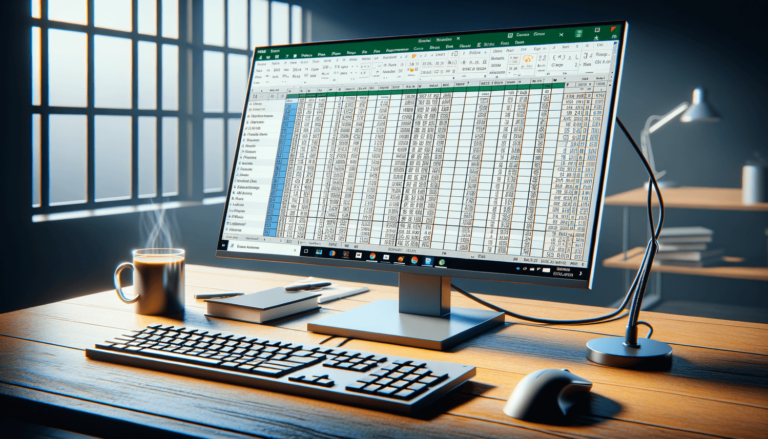

Microsoft Excel is a powerful tool that is widely used in various industries to organize, analyze and manage data. While there are numerous built-in functions in Excel that help simplify tasks, macros are a great way to automate repetitive tasks and save time. A macro is a set of instructions that can be recorded or written in Excel’s programming language, Visual Basic for Applications (VBA). This blog post aims to provide a concise and direct answer to the question of how to use macros in Excel.
Before we dive into the steps on how to use macros in Excel, let’s have a quick overview of what macros are and how they can be used. Macros are a set of recorded or written instructions that automate repetitive tasks in Excel. Whether you want to format data, create charts, or generate reports, you can use a macro to complete the task quickly and efficiently. Macros can be created by recording your actions and saving them as a macro or by writing code in Visual Basic for Applications (VBA), Excel’s programming language.
To create a macro, you first need to enable the Developer tab in Excel. Here’s how:
Once the Developer tab is enabled, you can start recording your macro. Here’s how:
After recording the macro, you will want to test it to make sure it works as intended. Here’s how:
Once you have created a macro, you can use it again in the future to automate the same actions. Here’s how:
That’s it! Now you know how to create and use macros in Excel to automate repetitive and time-consuming tasks. With a little practice, you can save yourself a lot of time and effort while performing complex data analysis or creating visually appealing reports and charts.
The use of macros in Excel comes with several benefits. Macros help you to:
If you need to edit or delete a macro, you can do so by following these steps:
If you want to create more complex and customizable macros in Excel, you will need to write the code in Visual Basic for Applications (VBA). VBA allows you to create loops, conditions, variables and more, giving you complete control over what your macro does. Here is an example of a simple macro written in VBA:
Sub Format_Data() 'Declare variables Dim LastRow As Long 'Find the last used row in column A LastRow = Cells(Rows.Count, "A").End(xlUp).Row 'Loop through all rows and format data as desired For i = 1 To LastRow If Range("A" & i).Value = "Yes" Then Range("B" & i).Interior.Color = RGB(255, 255, 0) End If Next iEnd SubThis macro formats data to highlight cells in column B that correspond with ‘Yes’ in column A. With a little practice, even beginners can learn to write simple VBA macros for commonly used tasks.
Macros are a powerful tool in Excel that help automate repetitive tasks, saving time and reducing the risk of errors. Users can choose to create macros by recording their actions or writing code using VBA. With a few easy steps, any Excel user can start creating and using macros to improve productivity and efficiency in their workflow.
Below are some frequently asked questions about using macros in Excel:
Yes, you can record a macro for almost any task you perform in Excel, as long as it involves a sequence of steps that are repetitive or time-consuming. Once you record a macro, you can use it repeatedly to save time and effort in your workflow.
It is always important to be cautious when downloading or opening files from unknown sources, as these may contain malicious code that can harm your computer or your data. Before using a macro, especially if it comes from an external source, you should scan it with an up-to-date antivirus program and review the code to ensure that you understand what it does.
Yes, macros can be very useful for data analysis in Excel. For example, you can create a macro that sorts and filters data based on specific criteria, or that generates charts or pivot tables to visualize data in specific ways. Macros can help you to analyze large datasets quickly and efficiently.
Yes, you can share macros with other users as long as they have the necessary version of Excel and the macro is compatible with their operating system. You can send the macro as a file attachment via email or save it on a shared drive where others can access it.
There are several resources available to help you learn how to write macros in VBA. Microsoft offers online tutorials and forums on its website, and there are many books and courses available online or in bookstores that cover the topic. You can also learn by reviewing existing macros and experimenting with modifying code to perform different tasks.
Explore the world of Microsoft PowerPoint with LearnPowerpoint.io, where we provide tailored tutorials and valuable tips to transform your presentation skills and clarify PowerPoint for enthusiasts and professionals alike.

Your ultimate guide to mastering Microsoft Word! Dive into our extensive collection of tutorials and tips designed to make Word simple and effective for users of all skill levels.

Boost your brand's online presence with Resultris Content Marketing Subscriptions. Enjoy high-quality, on-demand content marketing services to grow your business.
